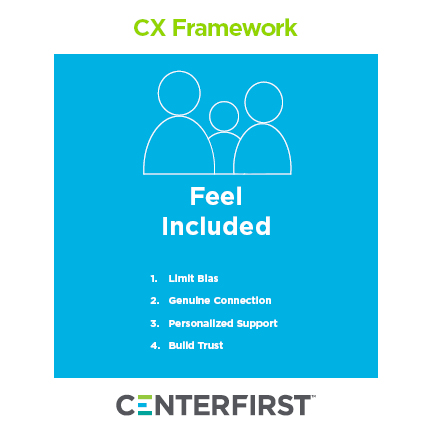Centerfirst CX Framework: Feel Included
Centerfirst’s CX Framework creates a foundation for contact centers to better understand where to focus their efforts to maximize the experience for their customers. The CX framework has five components: Be Heard, Needs Addressed, Feel Confident, Be Informed, and Feel Included. In this blog we will be discussing the Feel Included component and its significance.
Customers want to feel included. Creating an environment of warmth and understanding are key to maintaining a loyal customer base. When customers are treated with empathy, we help create a space where they feel safe and secure and are more willing to have open discussions that could lead to better patient adherence and outcomes. This also shines a light on the company; encouraging patients to share more information with them and improve customer loyalty throughout the process. Focusing on the Feel Included component can elevate a customer’s experience from good to outstanding.

The components of Feel Included are:
- Limit Bias: Accept who your customers are and what they bring with them and understand that all customers deserve a respectful, judgement free environment. Recognize the influence of conscious and unconscious bias.
- Genuine Connection: Establish a positive relationship with a “patient-first” approach, showing genuine empathy and compassion and creating meaningful and unforgettable customer experiences.
- Personalized Support: Understand your customer’s unique circumstances and perspective and reinforce positive behaviors to empower the customer. Advocate and plan for their needs beyond the product.
- Build Trust: Take actions that are in support of the customer’s desired outcome and show customers that their needs are understood and their opinion matters. Demonstrate loyalty through honesty and respect.
Jennifer Farrar, a Program Manager at Centerfirst, recently shared an experience relating to this component.
“A customer that feels respected, acknowledged, and heard, will almost always do more than what is expected. For example, Adverse Event phone calls can sometimes be very long and contain many questions asked by the agent to ensure an accurate report. When the agents are respectful and demonstrate genuine empathy, they are more likely to facilitate understanding and trust with the patient, thus the patient will be more likely to want to stay on the line with the agent longer in order to provide details for an accurate report.”

Putting time and effort into this component is key to success for the contact center to create a positive patient experience. Instead of asking basic, scripted questions, it’s important to ensure your interactions are genuine conversations that can create more meaningful dialogue. These conversations may be difficult ones for your customers to have, but once you establish an authentic interest and connection, they should feel more inclined to open up and provide you with the information you need to make more informed decisions at your contact center.
Read our full Centerfirst CX Framework white paper here.
If you are interested in learning more about this component of Centerfirst’s CX Framework, message us here.
